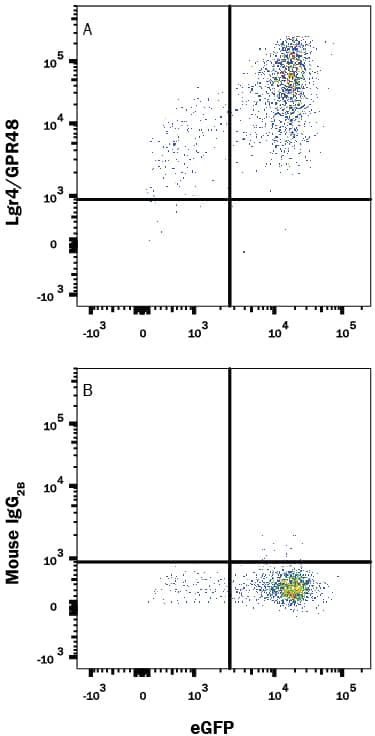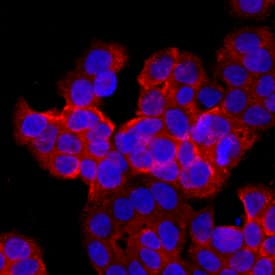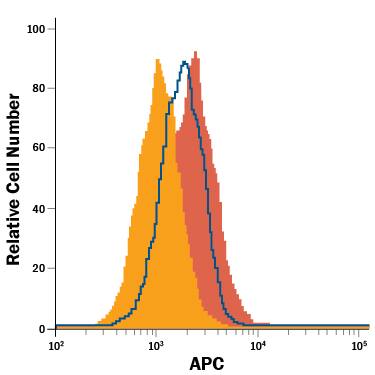Human Lgr4/GPR48 Antibody
R&D Systems, part of Bio-Techne | Catalog # MAB7750


Key Product Details
Species Reactivity
Applications
Label
Antibody Source
Product Specifications
Immunogen
Met1-Asp951
Accession # Q9BXB1
Specificity
Clonality
Host
Isotype
Scientific Data Images for Human Lgr4/GPR48 Antibody
Detection of Lgr4/GPR48 in HEK293 Human Cell Line Transfected with Human Lgr4/GPR48 and eGFP by Flow Cytometry.
HEK293 human embryonic kidney cell line transfected with human Lgr4/GPR48 and eGFP was stained with and either (A) Mouse Anti-Human Lgr4/GPR48 Monoclonal Antibody (Catalog # MAB7750) or (B) Mouse IgG2BFlow Cytometry Isotype Control (Catalog # MAB0041) followed by Allophycocyanin-conjugated Anti-Mouse IgG Secondary Antibody (Catalog # F0101B). View our protocol for Staining Membrane-associated Proteins.Lgr4/GPR48 in HT‑29 Human Cell Line.
Lgr4/GPR48 was detected in immersion fixed HT-29 human colon adenocarcinoma cell line using Mouse Anti-Human Lgr4/GPR48 Monoclonal Antibody (Catalog # MAB7750) at 10 µg/mL for 3 hours at room temperature. Cells were stained using the NorthernLights™ 557-conjugated Anti-Mouse IgG Secondary Antibody (red; Catalog # NL007) and counterstained with DAPI (blue). Specific staining was localized to cell surfaces. View our protocol for Fluorescent ICC Staining of Cells on Coverslips.R-Spondin 4 Binding to Lgr4/GPR48-transfected HEK293 Human Cell Line is Blocked by Human Lgr4/GPR48 Antibody.
In a functional flow cytometry test, biotinylated Recombinant Human R-Spondin 4 (100 ng/mL) binds to HEK293 human embryonic kidney cell line transfected with human Lgr4/GPR48 (dark orange histogram). Binding is completely blocked (light orange histogram) by 2.5 µg/mL of Mouse Anti-Human Lgr4/GPR48 Monoclonal Antibody (Catalog # MAB7750). Mouse IgG2B Isotype Control (Catalog # MAB004) at 2.5 µg/mL was used as a control (blue line). Cells were stained with Streptavidin-APC (Catalog # F0050).Applications for Human Lgr4/GPR48 Antibody
Blockade of Receptor-ligand Interaction
CyTOF-ready
Flow Cytometry
Sample: HEK293 human embryonic kidney cell line transfected with human Lgr4/GPR48 and eGFP
Immunocytochemistry
Sample: Immersion fixed HT‑29 human colon adenocarcinoma cell line
Formulation, Preparation, and Storage
Purification
Reconstitution
Formulation
Shipping
Stability & Storage
- 12 months from date of receipt, -20 to -70 °C as supplied.
- 1 month, 2 to 8 °C under sterile conditions after reconstitution.
- 6 months, -20 to -70 °C under sterile conditions after reconstitution.
Background: Lgr4/GPR48
Lgr4 (Leucine-rich repeat GPR 4), also known as GPR48 (G-Protein-coupled Receptor 48), is a seven-transmembrane glycoprotein receptor in the Lgr family of cell surface receptors (1, 2). While this family includes receptors for hormones such as LH, FSH, TSH, and HCG, the subfamily comprising Lgr4, Lgr5, and Lgr6 are G-protein-independent mediators of the potentiating effect of R-Spondins on Wnt signaling (1-6). Lgr4 binds and forms complexes with R-Spondins, Frizzled Wnt receptors and LRP Wnt co-receptors (5). It acts at least in part by enhancing Wnt-dependent LRP phosphorylation, internalization of LRPs, and accumulation of beta-catenin (3, 4). Human Lgr4 cDNA encodes 951 amino acids (aa), including a long N-terminal Extracellular Domain (ECD, aa 25-544) with 16-17 LRR domains that mediate ligand interaction (1). The LRR-containing ECD of human Lgr4 shares 93% aa sequence identity with mouse, rat and bovine Lgr4, and 50-60% aa identity with human Lgr5 and Lgr6. Lgr4 is widely expressed in both embryo and adult. Expression of Lgr4 mRNA in adult humans is highest in pancreas, followed by liver, heart, muscle, brain, and placenta (1). In rodents, embryonic and adult expression includes liver, kidney, adrenals, bone/cartilage, and heart (2, 7-9). Lgr4 deletion in the mouse affects development in areas of expression, for example, inhibiting fetal liver definitive erythropoiesis (9). Deletion of Lgr4 specifically from stem and progenitor cells in intestinal crypts induces loss of crypts due to insufficient Wnt signaling (5, 6). Lgr4 may be over-expressed in carcinomas and may promote invasiveness and metastasis by down-regulating p27Kip1 expression (10).
References
- Loh, E.D. et al. (2001) Biochem. Biophys. Res. Commun. 282:757.
- Hsu, S.Y. et al. (1998) Mol. Endocrinol. 12:1830.
- Carmon, K.S. et al. (2011) Proc. Natl. Acad. Sci. USA 108:11452.
- Glinka, A. et al. (2011) EMBO Rep. 12:1055.
- de Lau, W. et al. (2011) Nature 476:293.
- Ruffner, H. et al. (2012) PLoS ONE 7:e40975.
- Van Schoore, G. et al. (2005) Histochem. Cell Biol. 124:35.
- Mazerbourg, S. et al. (2004) Mol. Endocrinol. 18:2241.
- Song, H. et al. (2008) J. Biol. Chem. 283:36687.
- Gao, Y. et al. (2006) Cancer Res. 66:11623.
Long Name
Alternate Names
Gene Symbol
UniProt
Additional Lgr4/GPR48 Products
Product Documents for Human Lgr4/GPR48 Antibody
Product Specific Notices for Human Lgr4/GPR48 Antibody
For research use only

